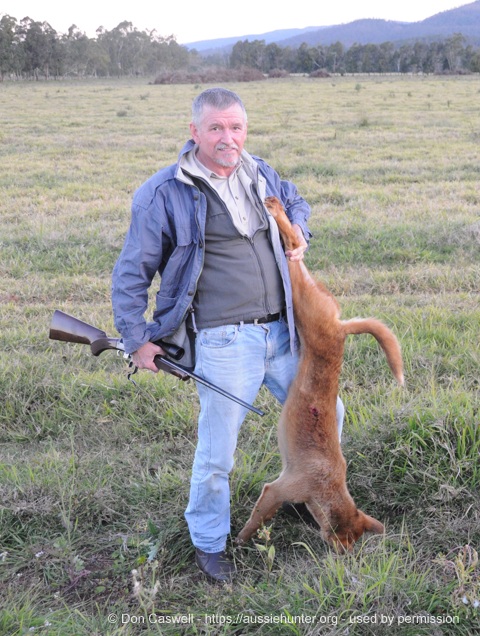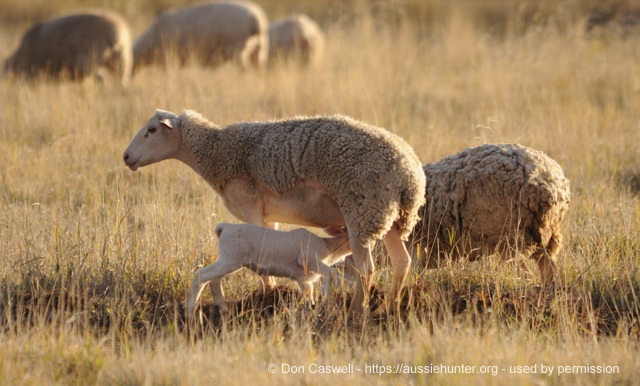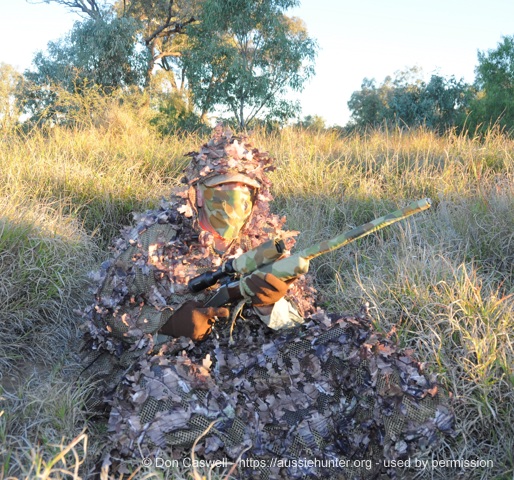
Hunting wild dogs is both fascinating and challenging. Don Caswell explains the basic essentials for repeated success.
It was 4pm on a mid-winter day as I split firewood in anticipation of another cold night. My mobile phone suddenly broke the silence. I stuck the axe into the chopping block and pulled the phone out of my jeans pocket. It was my hunting buddy Lindsay. “Jim just called; those wild dogs are back again, he can see them from the kitchen.”
“I’ll meet you at his farm in twenty minutes,” I replied. I took in the box of firewood, told my wife what was happening, and then retrieved my rifle and some ammunition before jumping into my vehicle.
As I drove down the narrow, one-lane access road between the farms I could see another ute about half a kilometre ahead of me. That was Lindsay. When I pulled into the farm house Jim was already at the car talking to him and pointing down toward the back corner of the extensive paddock.
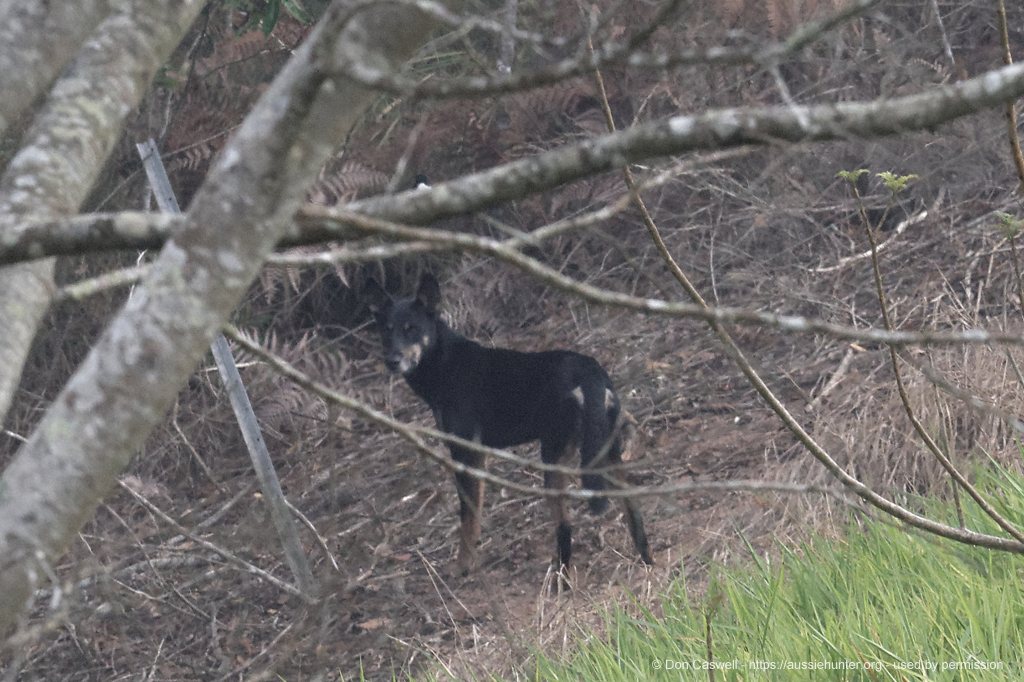
Our view was unimpeded. The paddock had only just been prepared for planting and there was nothing to obstruct our view. The boundary fence was a good 500 metres away. The rich, dark earth of the ploughed paddock was scattered with dozens of blue-grey shapes; a flock of Brolgas were feeding across the freshly-turned soil.
We scanned the fence line for some minutes. A group of Brolgas close to the fence suddenly scattered and a large red dog popped through the fence close to where they had been feeding.
“I saw a few piles of feathers when I was out in the paddock,” remarked Jim, “so, I guess they are varying their diet when they are not attacking my lambs and calves.” He sounded aggrieved. Less than a kilometre away, the farmland gave way to heavy bush and an extensive range of rocky hills that ran for many kilometres. It was a haven and breeding ground for wild dogs that regularly marauded surrounding farms.
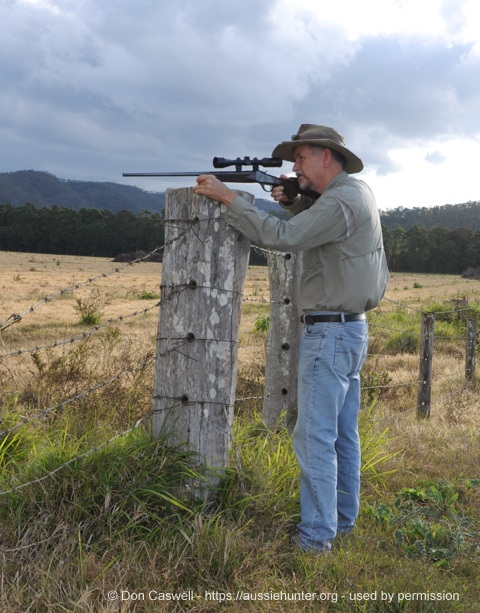
As we watched, two more dogs joined the first. They were all big solid dogs too. “There is a good dash of German Shepherd, or something similar, in those dogs. Look at the colour and big boof heads and neck on them,” commented Lindsay. Jim and I nodded in agreement.
Like elsewhere in the state, wild dogs are a growing menace and are generally big robust dingo-dog cross breeds. After a quick discussion we decided to take a roundabout path through the neighbour’s place, rather than directly across the paddock.
As we drove off Jim was on the phone to his neighbours telling them what was going on. Lindsay and I motored along slowly, coming up from behind the dogs at a slow and steady pace. They were accustomed to farm vehicles and there was a chance we might get within shooting distance.
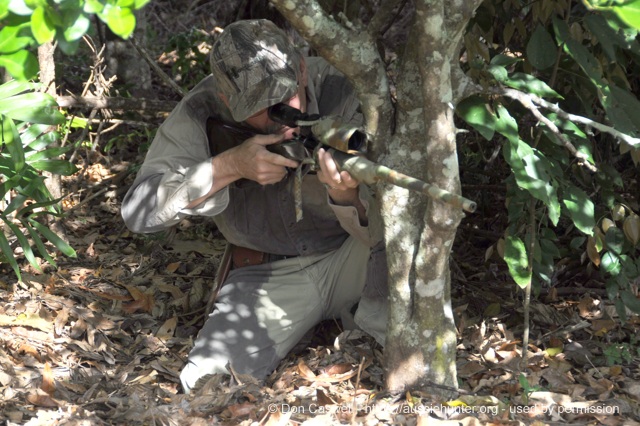
The distance closed and we were starting to think we were going to get lucky. However, once we were within about 400 metres the dogs started to head toward the nearby range. They were not alarmed, just cautious, and their steady pace began to extend the distance between us. We followed for over a kilometre and, even though they stopped briefly to look back at us, they kept increasing the separation.
We stopped the car and watched them eventually cross the neighbour’s fields and disappear into the bush on the far side of his paddocks.
It was dark when we got back to the farm house and the evening chill was settling in. It looked likely we would have another frosty night. The warmth of the farm house fireplace and a cup of tea were welcome. We chatted awhile with Jim and his wife.
For the past week they had seen the dogs pass down the boundary fence pretty much at the same time each day, about an hour before sunset. One of the dogs had also visited the farm house a couple of times when only the women were home. They were a little scared of the dog’s aggressive behaviour, when it showed it was in no mood to be shoed away.
Lindsay and I promised to return the next day, a bit earlier, and lie in wait. We both enjoy chasing wild dogs and have a number of properties where we concentrate on just that. These dogs gave every indication of being relatively easy to come to terms with, and we were pretty confident of a quick resolution of the problem.
At 4pm the next day we drove our vehicle into where we had seen the dogs the previous day. Conveniently, a tractor was parked close to the fence. We parked right in front of the big agricultural machine. It had been there for the best part of a week and the dogs were obviously used to its presence. Its bulk would effectively hide our vehicle from any approaching dogs. The wind was favourable to our plans as well.
I set up my FoxPro predator caller and decoy, about 100 metres out in the neighbour’s paddock. Back at the car I joined Lindsay in the cabin. I switched on the remote control and selected a rabbit distress call, figuring that the dogs would be more than familiar with that, given the number of bunnies in the area.
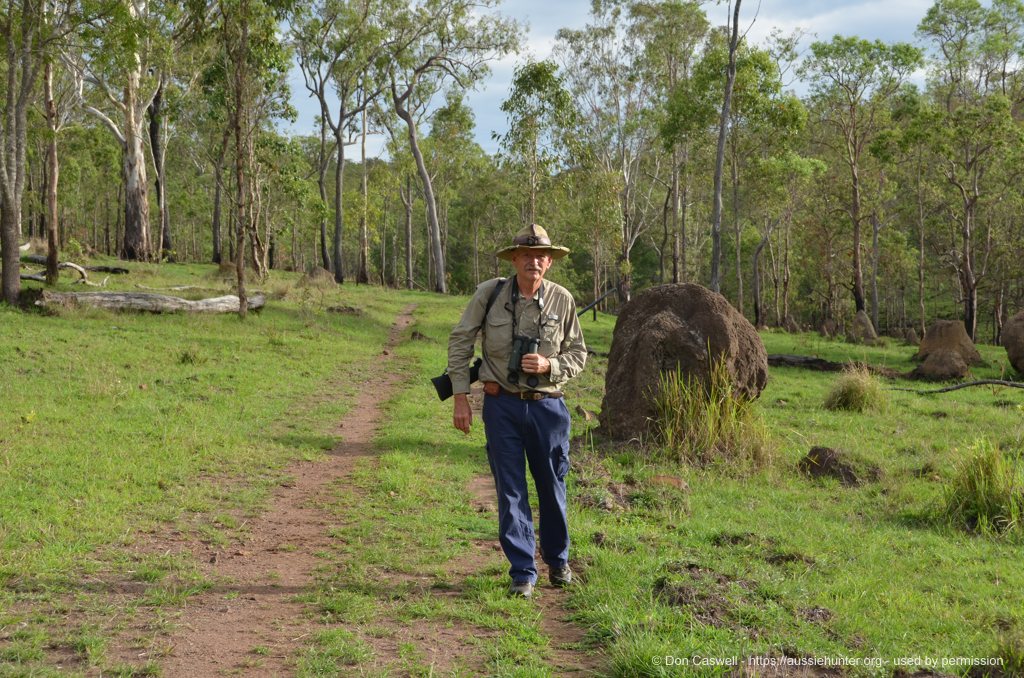
A steady, but sharp breeze was blowing and it was pleasant to be in the vehicle and out of the chill. After confirming we could hear the caller wailing away, we wound up the windows and chatted. A pair of magpies hastened over to investigate the decoy. A goshawk and a kite likewise detoured, to swoop low over the jiggling fuzz ball. Clearly the decoy was working well.
We had a good view down either side of the tractor and could see nearly a kilometre down the boundary fence. Lindsay and I figured we would see the dogs in plenty of time to be ready for a shot.
When I was not scanning up and down the fence line looking for dogs, I was checking out the wealth of birdlife around us. Time passed quickly as we kept watch and talked. The sun got close to the horizon, then slipped below it. We waited a little while longer as the light started to fade.
“Well, I reckon that is it for today. We can do the same thing again tomorrow, eh?” I said to Lindsay. He agreed. In anticipation of getting out in to the cold, I dropped the five cartridges into my shirt pocket and buttoned it closed. Then I zipped up my vest, followed by the jacket.
I stepped out of the car and was in the process of sliding my Browning single shot 223 back into the gun box when a movement caught my eye. Three burly red dogs came bounding past, not forty metres away, making a focussed bee-line for the decoy.
“Gosh!” I exclaimed, well something like that anyway, as I fumbled to get the rifle back out. Then as I hastened to retrieve some ammo, my vest zipper jammed! As I wrestled with my uncooperative clothing I watched the dogs go bounding up to the lure.
Lindsay cast me a glance that clearly said, “Don, what the hell are you doing?” as I flapped about trying to get a cartridge from within the straight-jacket my clothing had become. By the time I had wrecked my zipper and finally pulled a round of 223 from my pocket, the dogs’ demeanour had changed.
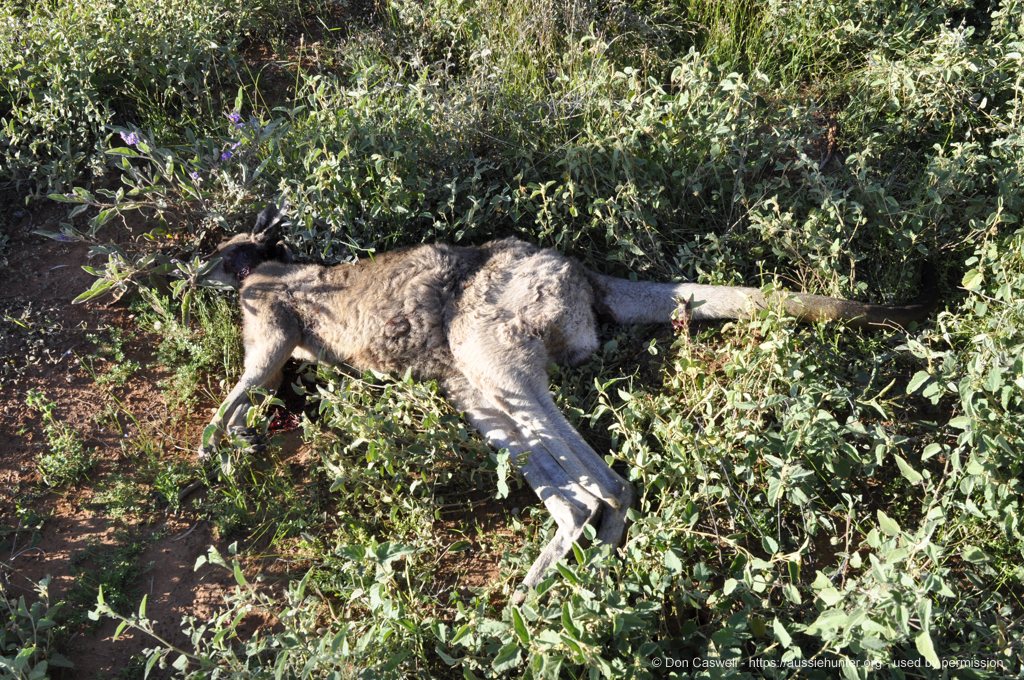
Their exuberant anticipation had turned quickly into wariness and they started to trot away. All three dogs were on the move, but one was much closer than the others. I chambered the cartridge and was in the act of bringing the rifle to shoulder when I noticed one of the other dogs had stopped and turned to look back at us from about 120 metres away.
I hastily changed my stance and squeezed off a shot. My aim was good I hit him just behind the point of the shoulder with a 55 grain Nosler Ballistic Tip. Through the scope I saw him flop instantly to the hit.
The two surviving dogs found top gear and disappeared at great speed. Climbing through the barbed wire fence, I walked up to my quarry, carefully approaching from behind. I was tentative in making contact. He was a big lump of a dog and could be dangerous if wounded. I gave him the poke in the eye test a couple of times before laying hands on him.
Apart from his big frame and bulk, the other thing I noticed was his strong aroma; he did not half pong! I rolled him over and noted that the projectile had left a good exit wound at the back of his off-side ribs after traversing the chest diagonally.
Lindsay had the camera out, with the ISO cranked right up for some quick pictures in the rapidly failing light as I lugged our prize back to the fence. We left him draped over a stump next to the fence so Jim and his neighbour could view the dog in the morning, before burying it.
Lindsay and I were feeling pretty pleased with ourselves as we drove back to the farm house to report in. But we were also a bit cranky with ourselves too. We had taken these dogs a bit too lightly. Because we expected a pretty easy hunt we had not taken as much care and preparation as we would normally on a dog hunt elsewhere. We really should have shot two, if not all three of those dogs. The survivors would now be educated and more difficult to call in on any future occasion.
In retrospect, one of us should have sat against the fence with some camouflage and been a lot more active with the binoculars. The other should have been similarly stationed, in a safe location, some distance away to cover any retreating dogs.
I have a few old cronies who, like me, enjoy chasing wild dogs. If you want your success on wild dogs to be more than just the odd, random encounter while hunting other species, there are a number of things you must pay attention to. We have collectively confirmed to our satisfaction what are the essentials for Wild Dog Hunting 101, as follows.
- Be aware of the wind, and use it to your advantage.
- Both hand-held and remote predator calls work a treat.
- A remote, active decoy with caller draws the dog’s attention and makes it much less likely to notice the waiting hunter.
- Camouflage clothing is worthwhile, essential if using a hand-held caller.
- Avoid using, or mask any reflective surfaces on your kit.
- Sit unobtrusively, keep still, don’t talk and be ready for action.
- Keep a good lookout. Use binoculars if you have them.
Of course there are lots of other tricky things you can do as well. Game cameras can be very useful in working what is coming and going, and at what times, from your area of interest. Scents, both attractive and masking can be used to good effect. Baiting (not poisoning) with feral animal carcasses, or dead stock, is also used by many. These aspects of wild dog hunting are fascinating subjects in their own right, but really they are in the category of Wild Dog Hunting 201, so we will leave that for another day.
© Don Caswell 2012
About the author
Since 1981 Don Caswell has been a freelance writer, photographer & illustrator. Don is the author of hunting stories and the provider of technical shooting information. Don an independent reviewer of hunting, shooting & outdoors products, in addition to being a blogger & webmaster with Facebook & Instagram presence. Don is also a senior writer for the Sporting Shooters Association of Australia (SSAA) and his articles appear regularly in their publications. This article was originally published in the SSAA in April 2014.
Visit Don Caswell's Aussie Hunter Website here

